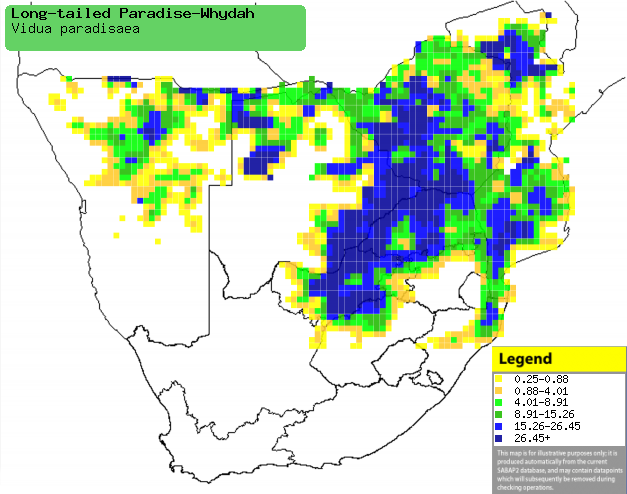|
Vidua paradisaea (Long-tailed
paradise-whydah, Paradise whydah)
Gewone paradysvink [Afrikaans]; uJojokhaya [Zulu];
Harusira (generic term for whydahs) [Kwangali]; Nyambubundu (also applied to
Broad-tailed whydah) [Shona]; Mitikahincila [Tsonga]; Smalstaart-paradijswida
[Dutch]; Veuve de paradis [French]; Spitzschwanz-paradieswitwe [German];
Viúva-do-paraíso-oriental [Portuguese]
Life
> Eukaryotes >
Opisthokonta
> Metazoa (animals) >
Bilateria >
Deuterostomia > Chordata >
Craniata > Vertebrata (vertebrates) > Gnathostomata (jawed
vertebrates) > Teleostomi (teleost fish) > Osteichthyes (bony fish) > Class:
Sarcopterygii (lobe-finned
fish) > Stegocephalia (terrestrial
vertebrates) > Tetrapoda
(four-legged vertebrates) > Reptiliomorpha > Amniota >
Reptilia (reptiles) >
Romeriida > Diapsida > Archosauromorpha > Archosauria >
Dinosauria
(dinosaurs) > Saurischia > Theropoda (bipedal predatory dinosaurs) >
Coelurosauria > Maniraptora > Aves
(birds) >
Order: Passeriformes > Family: Viduidae
Distribution and habitat
Occurs in sub-Saharan Africa from Ethiopia through Tanzania
to Zambia, Malawi, Angola and southern Africa. Here it is fairly common in
Zimbabwe, Mozambique, north-eastern South Africa, northern and south-eastern
Botswana and northern Namibia (including the Caprivi Strip), generally
preferring dry open savanna with scattered trees and bushes, such as Acacia,
miombo (Brachystegia) and Mopane (Colosphermum mopane) woodland,
also occupying adjacent fallow croplands and rural gardens.
|
 |
|
Distribution of Long-tailed paradise-whydah in
southern Africa, based on statistical smoothing of the records from
first SA Bird Atlas Project (©
Animal Demography unit, University of
Cape Town; smoothing by Birgit Erni and Francesca Little). Colours range
from dark blue (most common) through to yellow (least common).
See here for the latest distribution
from the SABAP2. |
Food
It mainly eats the seeds of grasses supplemented with
insects, doing most of its foraging on bare ground. The following food items have been recorded
in its diet in captivity:
- Seeds
- Grasses
- Panicum maximum (Guinea grass)
- Panicum schinzii (Sweet grass)
- Hyparrhenia hirta (Common thatching grass)
- Melitis repens (Natal red top)
- Sonchus oleraceus (Sowthistle)
- Synphytum officinale (Comfrey)
- Taraxacum (dandelions)
- Rumex (docks)
- Insects
Breeding
- It is a polygynous brood parasite, with males defending a territory of
about 3 hectares within which there are multiple perches used for
displaying, in an attempt to woo females. Interestingly males sometimes
display to females of other species, such as
Village indigobird. Its primary host is Green-winged pytilia, but it may
also parasitise
Violet-eared waxbill nests.
- Egg-laying season is from January-June, peaking from February-May.
- The female observes the hosts for at least 15 minutes before flying to
the nest to investigate, after which it lays 1-3 eggs, which hatch after
about 11 days of incubation
- The chicks look similar to the host's chicks, even mimicking their
begging and feeding behaviour. In captivity the whydah and host chicks left
the nest together after 16 days; the whydah becomes fully independent at
about 27-30 days old.
Threats
Not threatened.
References
-
Hockey PAR, Dean WRJ and Ryan PG 2005. Roberts
- Birds of southern Africa, VIIth ed. The Trustees of the John Voelcker
Bird Book Fund, Cape Town.
|
